Shrimp Jambalaya – This one-pot meal combines Creole and Cajun cooking. Packed with juicy shrimp, smoky sausage, tender vegetables, and fragrant rice, it’s a hearty dish that brings the soul of Southern cooking right to your kitchen.
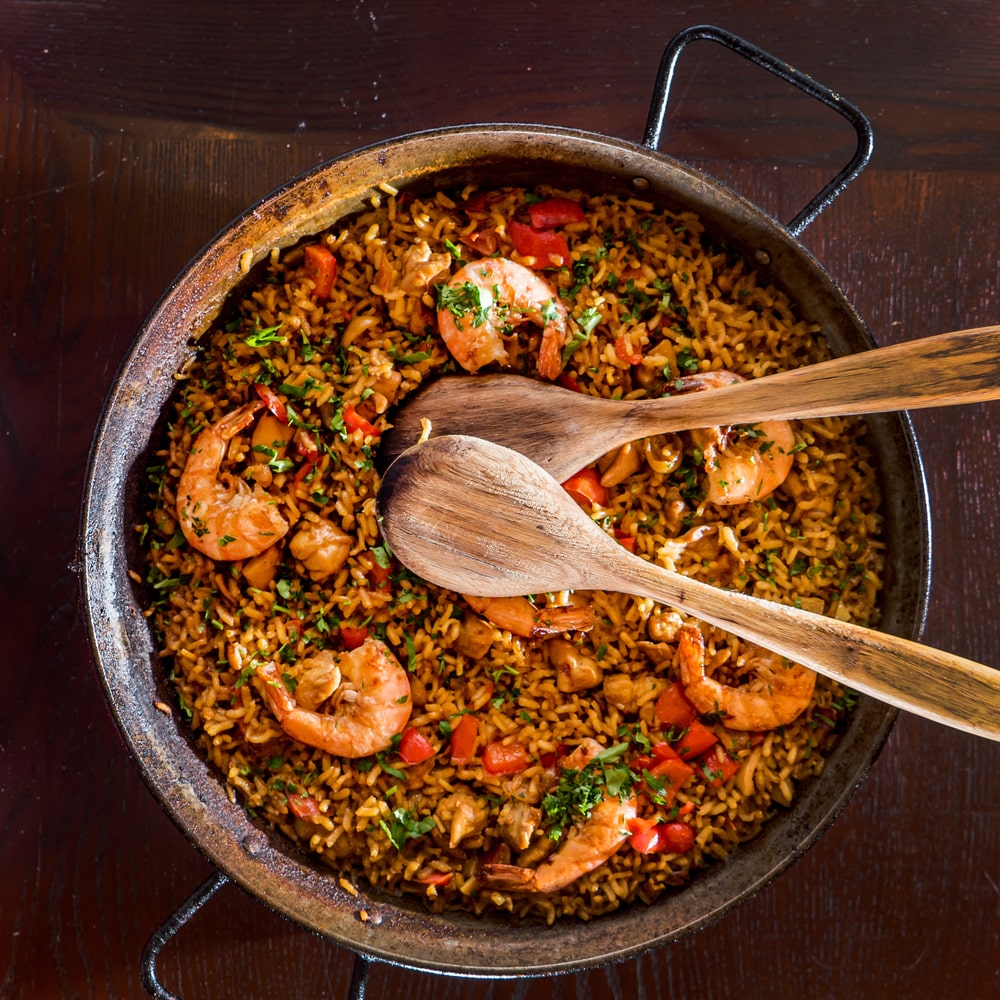
What is Shrimp Jambalaya?
Jambalaya is a Southern staple, typically made with a mix of meats, vegetables, and rice cooked together in a single pot. Shrimp Jambalaya specifically highlights seafood, which is abundant in the coastal regions of Louisiana. The recipe draws influences from Spanish, French, and West African cuisines, which all contribute to its bold and complex flavor profile.
Pro Tip: The key to authentic jambalaya is building layers of flavor—starting with sautéing aromatic vegetables (like the “Holy Trinity” of onions, celery, and bell pepper) before adding spices, proteins, and rice.
Tips and Tricks for the Perfect Shrimp Jambalaya
Heat levels: If you love spice, feel free to add more Cajun seasoning or toss in some cayenne pepper. If you’re sensitive to heat, opt for mild sausage and reduce the amount of seasoning.
Choose the right sausage: Andouille sausage is traditional for jambalaya because of its smoky, spicy flavor. If you can’t find andouille, try using chorizo or kielbasa for a similar taste.
Shrimp cooking tip: Add shrimp towards the end to avoid overcooking. Shrimp cook quickly and can turn rubbery if left in too long.
Rice matters: Use long-grain rice for the best texture. Short-grain or sticky rice can make the jambalaya too mushy.
One-pot magic: Jambalaya is all about layering flavors. Sautéing the sausage and vegetables first allows them to develop deep, rich flavors that infuse the whole dish.
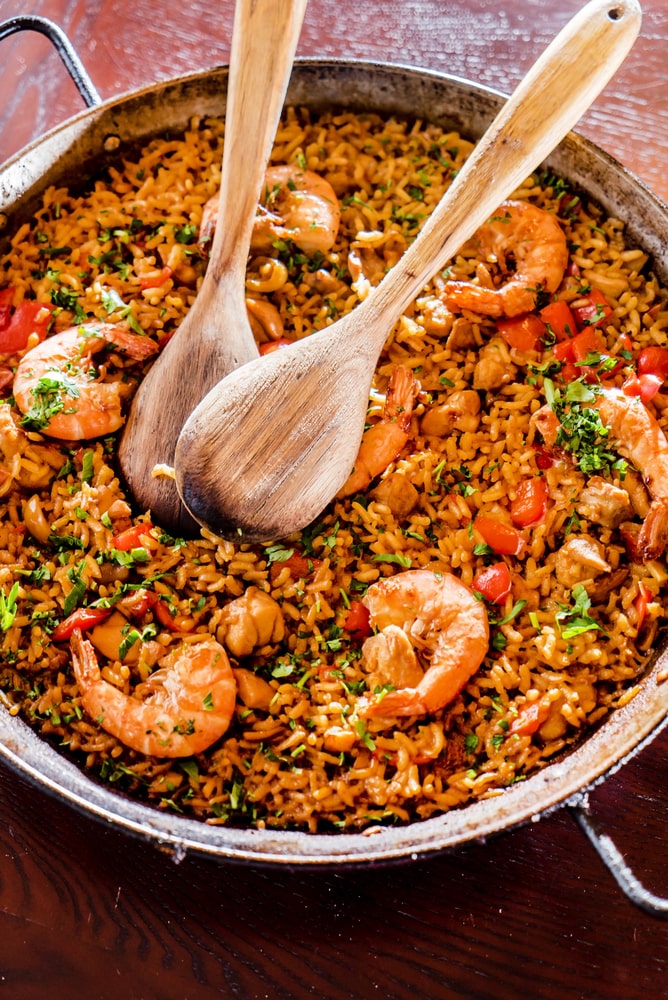
Variations of Shrimp Jambalaya
While the classic Shrimp Jambalaya is incredibly delicious, there are many ways to customize this dish based on your preferences and available ingredients.
Chicken and Shrimp Jambalaya
Add diced chicken breast or thighs to the mix! Brown the chicken first, set it aside, and then add it back into the pot when cooking the rice for a more protein-packed meal.
Vegetarian Jambalaya
For a vegetarian version, swap the shrimp and sausage for plant-based alternatives. You can also bulk up the dish with extra vegetables like zucchini, carrots, or mushrooms. Use vegetable broth in place of chicken broth for a fully vegetarian meal.
Seafood Jambalaya
If you’re a seafood lover, add additional seafood like crab, crawfish, or scallops. These can be added towards the end, just like the shrimp, to keep the seafood tender and juicy.
Low-Carb Shrimp Jambalaya
If you’re cutting back on carbs, you can substitute the rice with cauliflower rice. Add the cauliflower rice near the end of cooking to prevent it from getting mushy.
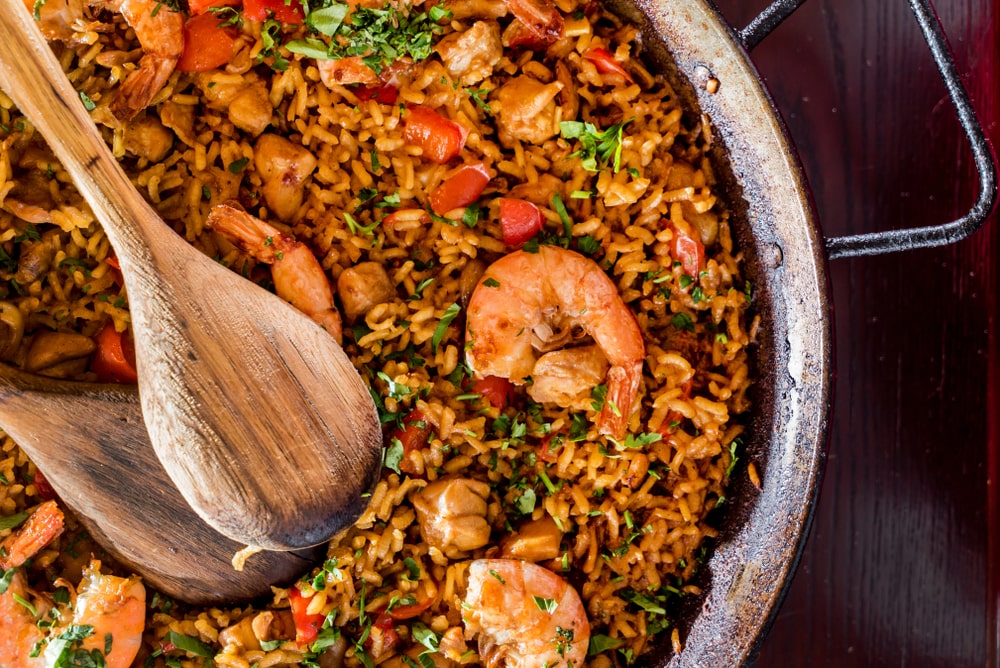
How to Serve Shrimp Jambalaya
Shrimp Jambalaya is a hearty dish that can be served on its own, but it pairs beautifully with a few Southern-inspired sides. Here are some ideas for a complete meal:
Crisp salad: A simple green salad with a tangy vinaigrette can provide a refreshing contrast to the bold flavors of the jambalaya.
Cornbread: A slightly sweet cornbread helps balance the spiciness of jambalaya.
Green beans: Lightly sautéed or roasted green beans make for a fresh, crisp side.
Collard greens: A classic Southern side dish, collard greens bring an earthy flavor that complements the rich jambalaya.
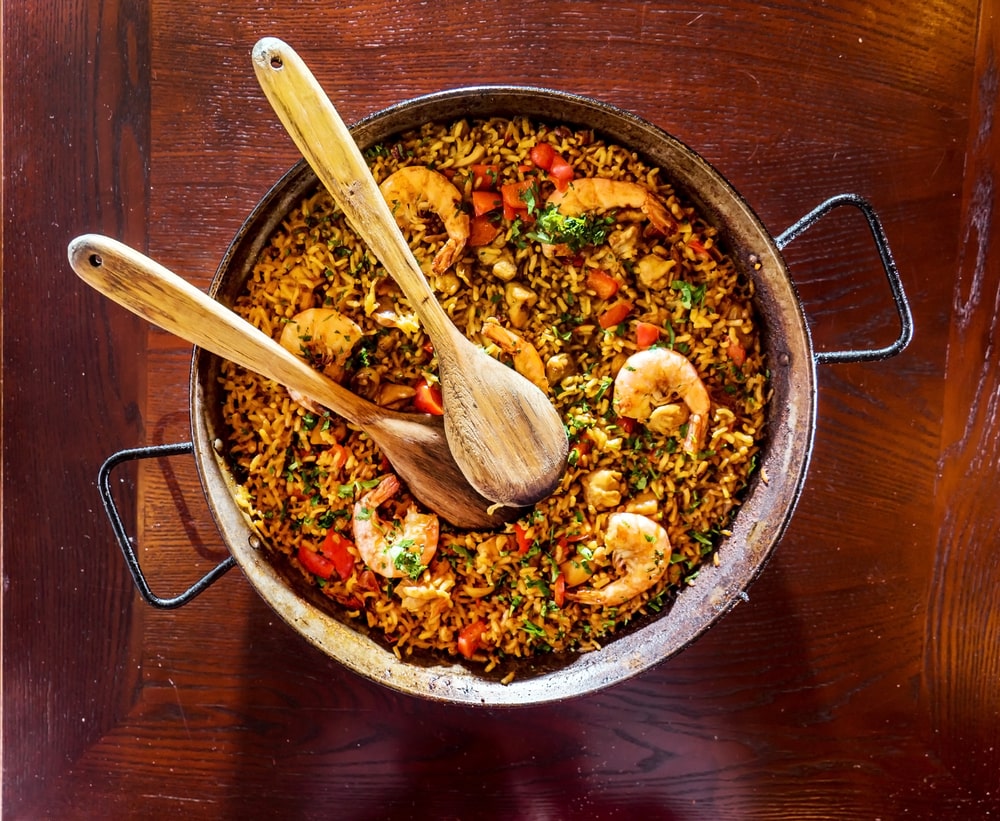
Storing and Reheating Shrimp Jambalaya
This dish is perfect for meal prepping as it stores well and reheats beautifully.
How to Store:
- In the fridge: Store leftovers in an airtight container in the fridge for up to 3 days.
- In the freezer: Shrimp Jambalaya can be frozen for up to 3 months. To freeze, let the dish cool completely before transferring it to freezer-safe containers.
How to Reheat:
- Stovetop: Reheat on the stovetop over low heat, stirring occasionally, until warmed through.
- Microwave: You can also microwave individual portions in a microwave-safe dish. Cover the dish with a lid or plastic wrap to keep the moisture in while reheating.
Pro Tip: If you’ve frozen your jambalaya, let it thaw in the fridge overnight before reheating to maintain the best texture and flavor.
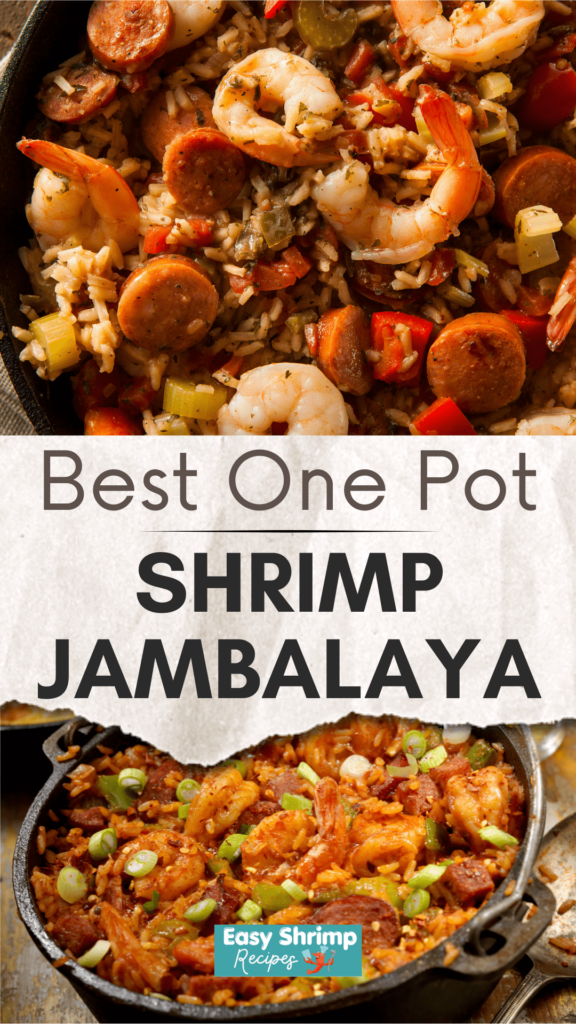
Shrimp Jambalaya Recipe FAQs
Q: Can I make jambalaya ahead of time?
A: Yes! Jambalaya tastes even better the next day, so making it ahead of time can help the flavors meld together.
Q: Can I use brown rice instead of white rice?
A: You can, but you’ll need to adjust the cooking time. Brown rice takes longer to cook, so add about 10-15 minutes and check for doneness.
Q: What’s the difference between Creole and Cajun jambalaya?
A: Creole jambalaya (like the one in this recipe) includes tomatoes, while Cajun jambalaya does not. Both are delicious but offer slightly different flavor profiles.
Q: How do I prevent my shrimp from getting tough?
A: The key is to add shrimp in the last few minutes of cooking. Shrimp cook very quickly, so only cook them until they’re pink and opaque.
Shrimp Jambalaya (One Pot)
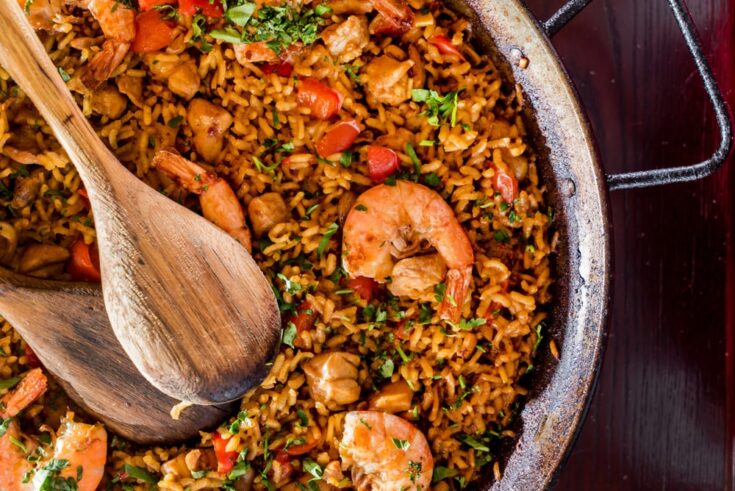
Shrimp Jambalaya - This one-pot meal combines Creole and Cajun cooking. Packed with juicy shrimp, smoky sausage, tender vegetables, and fragrant rice, it's a hearty dish that brings the soul of Southern cooking right to your kitchen.
Ingredients
- 4 Tbsp. extra-virgin olive oil, divided
- 1 1/2 lbs. peeled and deveined raw shrimp
- 1 1/2 tsp. salt, divided
- 1/2 tsp. black pepper
- 1 medium yellow onion, finely chopped
- 2 ribs celery, finely chopped
- 2 large (or 3 small) bell peppers, any color (I love using a mix of green, red, and orange)
- 8 oz. baby bella (cremini) mushrooms, sliced
- 4 garlic cloves, minced
- 2 Tbsp. Cajun or Creole seasoning
- 1 tsp. dried thyme
- 1/4 to 1/2 tsp. cayenne pepper (depending on how spicy you like it!)
- 1 1/2 cups uncooked long-grain white rice
- 1 (14-oz.) can crushed tomatoes
- 3 cups lower-sodium vegetable or chicken broth
- 1 bay leaf
- 1/4 cup finely chopped fresh parsley or green onion for garnish
- Juice of 1 lemon
- Sliced green olives for garnish (optional but recommended for a burst of briny flavor)
Instructions
- Start by patting your shrimp dry with a paper towel—this will help them sear nicely in the pan. Season the shrimp evenly with 1/2 teaspoon each of salt and black pepper.
- Heat 2 tablespoons of olive oil in a large, high-sided skillet over medium-high heat. Once the oil is hot, add half of the shrimp in a single layer. Cook for about 3 minutes on one side, then flip and cook for an additional minute, until the shrimp are just cooked through and pink. Remove the shrimp and set them aside on a plate.
- Repeat the process with the remaining shrimp, and keep them covered to stay warm while you work on the rest of the dish.
- Now that your shrimp are perfectly cooked, it’s time to build those deep layers of flavor. In the same skillet, add the remaining 2 tablespoons of olive oil. Toss in your finely chopped onion, celery, bell peppers, and mushrooms. Sauté for 8 to 10 minutes, stirring occasionally, until the vegetables are soft and fragrant.
- Pro Tip: Don’t rush this step—letting the vegetables soften fully will ensure your jambalaya has a rich, well-developed base.
- Once your vegetables are nicely softened, stir in the garlic, Cajun seasoning, thyme, and cayenne pepper.
- Now it's time to add the rice. Stir well to coat the rice in the seasonings and allow it to toast slightly for 3 to 4 minutes. This step not only enhances the rice’s flavor but also ensures it absorbs all those wonderful spices.
- Next, pour in the crushed tomatoes, broth, and toss in the bay leaf. Add the remaining 1 teaspoon of salt, and give everything a good stir to combine. Bring the mixture to a simmer, then reduce the heat to medium-low.
- Cover the skillet and let it simmer gently for about 30 minutes. During this time, the rice will absorb all the delicious flavors and the broth, becoming tender and fluffy. Make sure to give it a stir every 5 to 10 minutes to prevent the rice from sticking to the bottom of the pan.
- Once the rice is cooked and the liquid is absorbed, it’s time to bring everything together. Remove the bay leaf, then stir in your cooked shrimp to rewarm them gently. Taste the jambalaya and adjust the seasoning as needed—you may want to add a touch more salt or a dash of spice depending on your preference.
- Finish off the dish by garnishing with chopped fresh parsley or green onions, a generous squeeze of lemon juice, and, if you’re feeling fancy, a few sliced green olives. These optional olives add a delightful briny kick that complements the rich flavors of the jambalaya.
Nutrition Information
Yield
6Serving Size
1Amount Per Serving Calories 267Total Fat 10gSaturated Fat 2gTrans Fat 0gUnsaturated Fat 8gCholesterol 96mgSodium 2344mgCarbohydrates 29gFiber 6gSugar 6gProtein 15g
Easy Shrimp Recipes.com, occasionally offers nutritional information for recipes contained on this site. This information is provided as a courtesy and is an estimate only. This information comes from online calculators. Although allchickenrecipes.com attempts to provide accurate nutritional information, these figures are only estimates.
Final Thoughts
Shrimp Jambalaya is a flavorful, comforting dish that brings the vibrant essence of Louisiana cuisine right to your table. Whether you stick with the classic recipe or add your own twist, it’s a meal that’s sure to impress your family and friends. So, grab your ingredients, fire up that stovetop, and enjoy a steaming bowl of this Southern delight!
Check my other shrimp recipes:

